
The Most Underrated U.S. Cities for Real Estate Investments
A recent study by Badeloft USA identified the most underrated cities for real estate investments in the US by analyzing safety, affordability,
A farmhouse, also referred to as apron front sink or country sink, is a drop-in sink that has an exposed front-facing side. This means that they are designed to be added to a space cut out especially for the kitchen counter in an effort to blend seamlessly with a kitchen counter for aesthetic purposes.
Farmhouse sinks are generally very large, with the design intended for those without running water, able to store water on one side while the other allows for multi-purpose use such as washing laundry, kitchen duties and even washing children. And while not many are used for these heavy duty roles, it is undeniable that farmhouse sinks add a rustic and homely feel to a kitchen that is hard pressed to find anywhere else.
A farmhouse sink provides you with a large sink area which is great for organizing your kitchen. The exposed apron also makes it easier to wash items such as pots, pans, and baking sheets. Additionally, you can soak your cookware in the added space before adding them to the dishwasher. Farmhouse sinks are not very common for bathrooms as the added space is not needed for grooming needs.
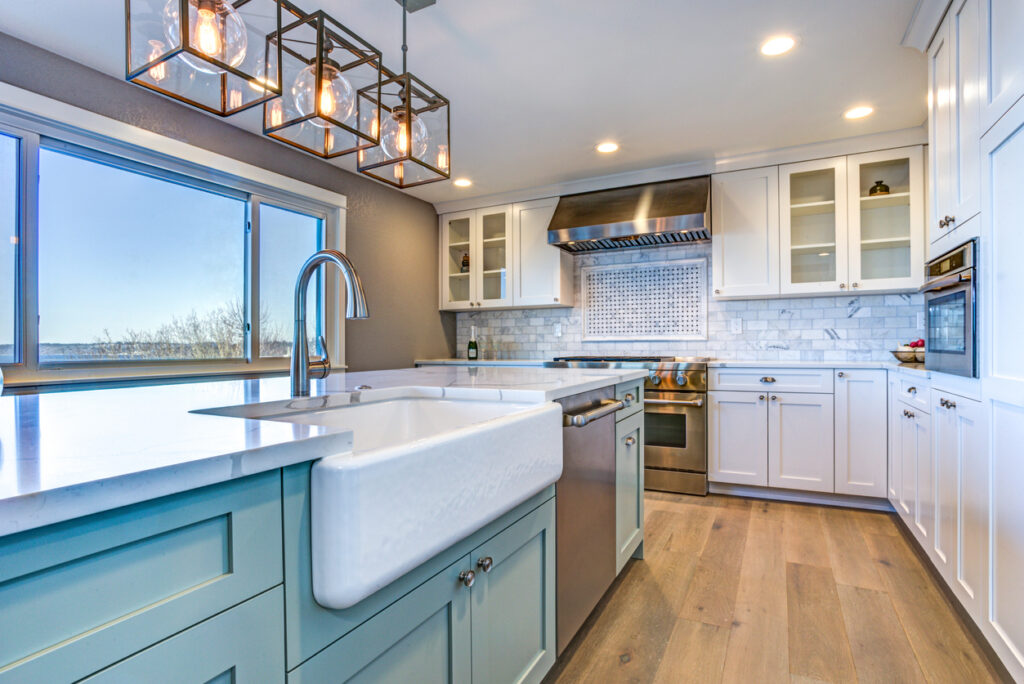
Since farmhouse sinks have a large amount of space available, their design is allows some variation in catering to your individual needs. With that, the two most popular variations would be the Drainboard sink and the Laundry sink. Of course these two serve as quick short hand models and you are free to customize them in other variations, but these two do tend to cover most of the bases.
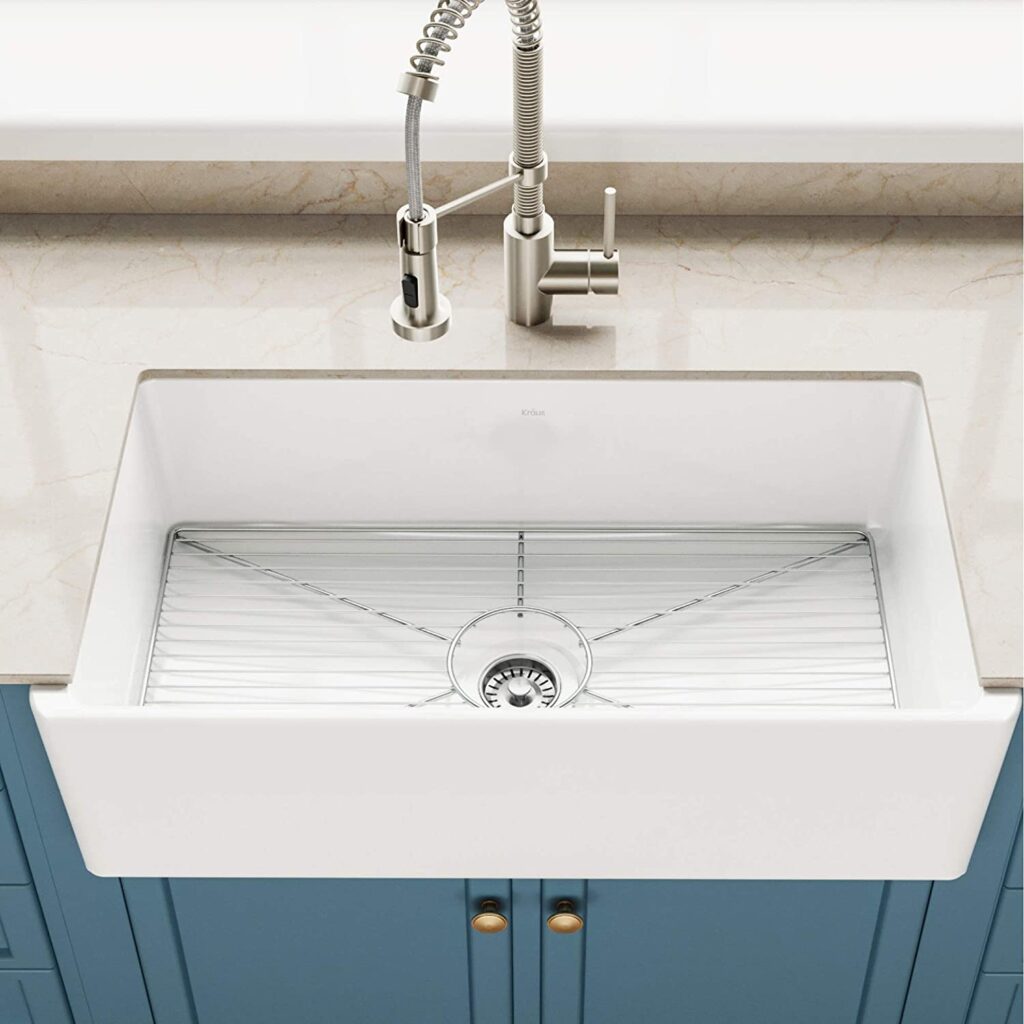
The laundry sink functions more or less as an iconic farmhouse sink design. It houses anywhere between one to two deep basins, roughly measuring around 9 inches deep. This design allows you to hold a significant amount of water in one basin while the other can be used for a multitude of chores such as washing dishes, cooking prep and laundry.

The drainboard design on the other hand, is useful for washing dishes and keeping water off your countertop. The key feature is an attached apron on the side which is grooved, allowing it to catch any excess water. The apron then filters the water back into your sink, allowing your surface area to be kept dry. This differs from the usual laundry design in that there is usually only one basin in this design as the other space is taken up by the grooved apron or drainboard.
As with most kitchen and bath items, you are afforded a wide plethora of materials to choose from. In the case of farmhouse sinks the most common options would be Cast Iron, Natural Stone, Bronze, Stainless Steel, Copper and Fireclay. Each material’s strengths and weaknesses ultimately reflect on three categories: durability, aesthetic appeal and of course price. When choosing the right material for your sink, be sure to prioritize which of those three is most important to you.
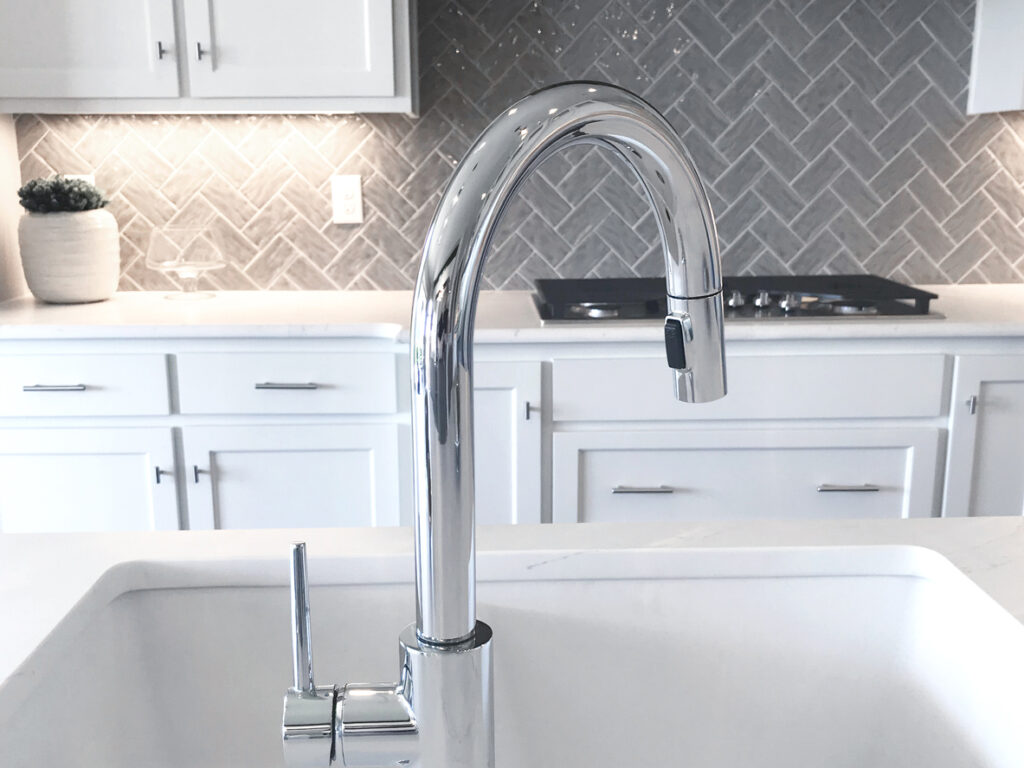
Ceramic sinks are cast iron sinks coated with a layer of porcelain or a protective layer of ceramic. The benefit of this is a sink that has a hard, glossy, glass-like surface, adding to the appeal of being very timeless. This material while durable in a sense, can easily chip or discolor through heavy use. It’s also quite heavy and will require additional reinforcement when installing.
Pros
Cons
A sink constructed from natural stone such as travertine, granite, limestone or marble adds a unique flair to any home. With natural stone, your sink is very aesthetically pleasing and highly durable in extreme heat as well as heavy impacts and abuse. The material is also non-porous, easy to clean and can easily last hundreds of years if properly resealed.
The drawbacks to natural stone would be that it is a great deal more expensive than almost any other material on the market aside from copper and bronze. Lastly, natural stone is great deal heavy as well, requiring additional reinforcement to support it.
Pros
Cons
A material with antibacterial properties, bronze is an attractive material that won’t rust or corrode. If you are looking for a material that is highly attractive, durable and unique, bronze is an excellent choice. The material will continue to patina and darken with age and use, deepening its color over time. The only drawback to bronze is that for aesthetics, you are looking to pay a heavy sum, more than any other material on the market.
A classic material for professional kitchens, stainless steel sinks are known to be durable, strong and easy to clean. Their primary selling point is their high durability, allowing them to take a heavy amount of abuse and still hold up quite well. The caveat with this is that you want a steel gauge around 16-18 at the very least, otherwise the steel will be less durable.
It is also available in a large variety of styles and sizes and is a great deal lighter than most other sink materials, allowing you to forgo having additional supports placed. The only negative with this material is that stainless steel is quite loud when compared to other materials. Aesthetically it is also very limited, having only one color available.
Pros
Cons
Copper sinks are made by melting copper ore at high temperatures, pouring them into sink molds. The result is a material that is naturally unique with a patina that continues to develop more and more with use. Copper also continues antibacterial properties which are ideal for a bathroom or kitchen.
Pros
Cons
Constructed from clay that is glazed and then fired at high temperatures, fireclay is a very hard and durable ceramic material, identical physically to enameled cast iron. In addition to being durable, the material is non-porous, resistant to acid, alkali and scratch and chip resistant. The drawbacks to this durability is that dropped dishes don’t handle the impact against fireclay very well.
The material will also chip and flake over time and does have a tendency to crack with heavy use. And similar to cast iron, it will require additional support due to its weight.
Pros
Cons

With sinks, the colors available to you will depend largely on the material of your sink. Of course you are free to customize your sink’s color as you see fit, but certain colors blend differently with your kitchen’s aesthetics so you might want to lean towards matching or amplifying the color of your kitchen.
The two most popular colors on this end would be black and white, allowing you to pair black with a darker kitchen aesthetic or white for a more vibrant appeal. Black may be more ideal for a more modern look to your kitchen while white can be used for a more classic approach, adding in that farmhouse feel.
Farmhouse sinks come in three different styles, designed to fit a multitude of different homes and shapes. The style you choose comes down to two factors: ease of installation and aesthetic. Since this determines how your sink is used, it is important to choose the style that suits you.
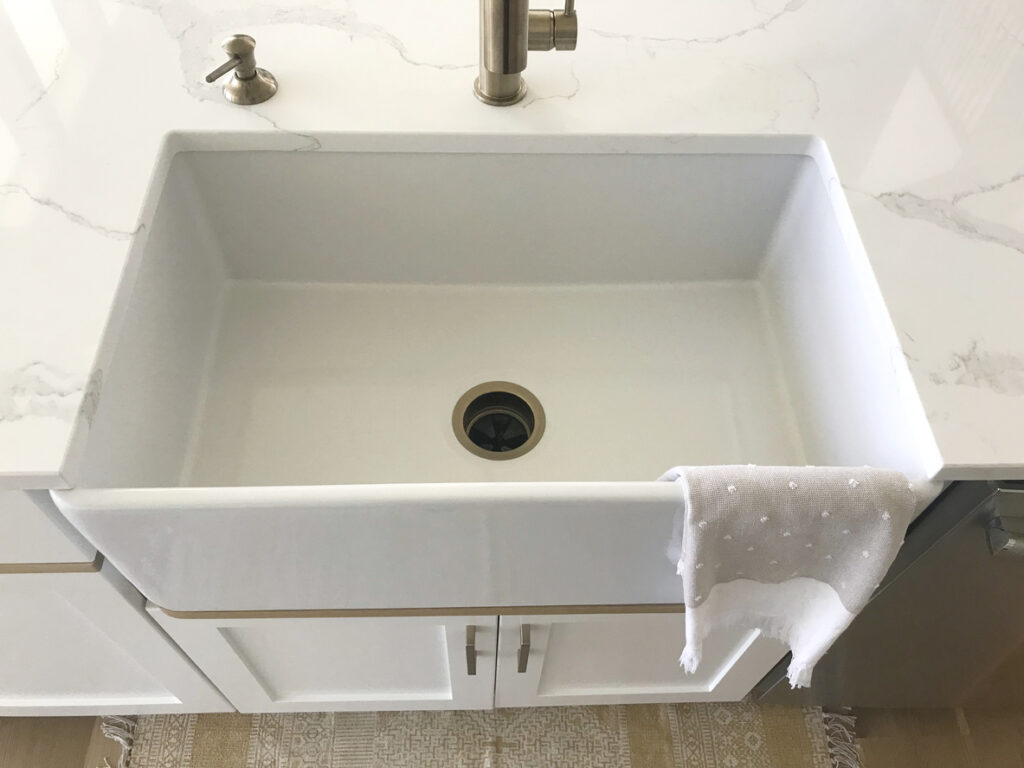
The deep drop in style has a more modern approach as the sink is installed via drop-in method, making the design rectangular in shape. The shape gives this design more of a compact space, allowing drop-in farmhouse sinks to be available in single, double or even triple bowl styles. However, since these sinks are dropped in, additional supports should be placed to reinforce the sink as it does not have a wall anchor.
Top mount styles are popular as they do not require leveling out an entire countertop. These sinks are installed on top of the counter, allowing for more cabinet space as the sink is installed directly on top of your existing countertop. This style is much cheaper as you do not have the installation costs of removing existing space. The only drawback is that the sink generally won’t be flush with the counter, allowing dirt and other particles to be lodged in the space between your sink and the counter.
Vintage style is the typical style that you see when you think of farmhouse design which tends to be more rounded compared to the more rectangular shape of the other styles. It has either one or two bowls, comes in a variety of sizes and is usually made from porcelain wrapped cast iron or white fireclay. This style is generally wall mounted and installed with a drop-in style. It can either support itself or be anchored by an existing counter.
Compared to other sinks, farmhouse sinks tend to be a great deal larger, so it is important to find the correct size for your kitchen based on the measurements of your kitchen. You may need to remove and replace countertops and remodel part of your kitchen to make the sink fit.
Farmhouse sinks measure anywhere between 20 inches to 60 inches in length with an average height of 9-10 inches. You can always shorten the length, but the height will always remain the same, meaning that at the smallest tier, you are looking at a sink that is 20 inches long, 16-20 inches wide, and a height between 8-10 inches. So, choose the right bathroom sink size is crucial. In bathrooms, sinks ranging from 20-24 inches are considered small, while those from 30-40 inches are average or medium-sized, with anything beyond that considered large.
Farmhouse sinks make great everyday sinks but they are a fair bit larger than the average sink, making it more difficult for smaller sized individuals to use. Below is a list of pros and cons about farmhouse sinks that you should consider before purchasing one.
Pros:
Cons:

Before you purchase a farmhouse sink, there are a few things to consider:
Farmhouse sinks are made from dense materials that increase their durability. However, if you toss your dishes in the sink, you can easily end up with broken dishes. With a farmhouse sink, you need to exert more care in your plates and glassware to prevent any unfortunate accidents.
Porcelain sinks require great care, and if you choose a white sink, be prepared to deal with staining. You can use baking soda and scrubbing to remove some stains, but be prepared for frequent cleaning if you choose porcelain. If this doesn’t appeal to you, consider an easier material such as stainless steel or natural stone.
Farmhouse sinks are quite large, so you may have to adjust your countertop to support the additional space and weight. Ensure that your counter and cabinets are reinforced before installing. Additionally, the extra size can make it difficult to fill with water and you lose a fair bit of under-sink storage as a result.
Installing a farmhouse sink may come with hidden costs such as countertop replacement and cabinet remodels. But in addition to supporting the sink, you may need to reorder your plumbing as well. A farmhouse sink is deeper than a typical sink, so your drain needs to be adjusted to drain properly. In addition, conveniences such as garbage disposals will be much more expensive to install as many are not sized for farmhouse sinks requiring attachment flanges to fit, so bear that in mind.
If you have older cabinetry in your kitchen and are not willing to get rid of it, you will need to check and measure well the possibility of installing a farmhouse sink in your kitchen. Farmhouse sinks are quite heavy, so your older cabinetry might not be able to carry out all that weight. As most homeowners typically worry about the size of the farmhouse sink, they tend to ignore the fact that this sink type is heavier than other models on the model, making it challenging to work with certain materials and cabinetry. Before making any decision, do your research and calculations.
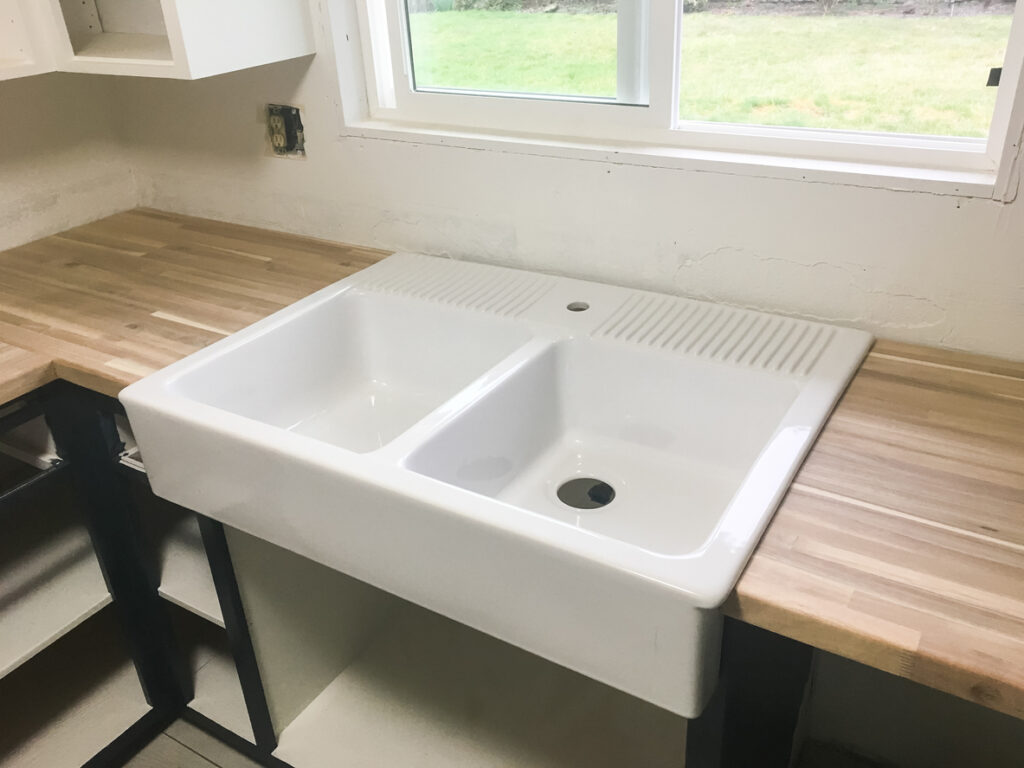
This answer will ultimately depend on your household’s needs, but for daily use, stainless steel is the best material; its inexpensive, durable, easy to clean, and comes in many different styles. Copper and natural stone are the best material for quality and longevity, but they are much more expensive and require many more considerations such as additional weight for your counter.
Fireclay and cast iron have a classic appeal, but cannot survive heavy impacts and are prone to cracking through heavy use.
Farmhouse sinks aren’t for everyone and two main things you should consider before you purchase one are: installation costs and it’s size. Because these sinks tend to be quite large, a good chunk of your kitchen or area will need to be removed or remodeled to accommodate it, so be wary of hidden costs that will occur.
You can typically buy a farmhouse sink for anywhere between $250-350. Of course this is the extreme low end and the sink material will typically be cast iron. If you want something more durable such as stainless steel, your price will increase immediately to $400-800. This is typically the range of almost all farmhouse sinks though if you want a material such as bronze or natural stone, this price will jump to anywhere between $900-1200.
Farmhouse style sinks are available in nearly all retail hardware stores such as Home Depot, Lowes, Amazon or Walmart. However, the range of materials will differ from store to store. If you are looking for a specific material type, it would be better served to find a specialty store online to serve your needs. Of course these will be much more expensive than retail hardware stores, but the cost is usually worth it for a material that better suits your home.
Yes, it is safe to say that farmhouse sinks have always been in style. Negatives aside, a farmhouse sinks provides a visual appeal that no other sink can really match. However, more modern designs favor a more sleek and minimalist approach as space is a premium in many homes.
Certainly! Here’s the revised paragraph with “MODERN BATHROOM SINKS” included:
This is where farmhouse sinks tend to fall off as they are quite large and not every home can support the size. In short, for many apartments, farmhouse sinks are generally seen as a waste of space whereas for homes, it can provide a rustic, more comforting aesthetic. Modern bathroom sinks, on the other hand, offer sleek designs that are often more suitable for smaller spaces like apartments, balancing functionality and style efficiently.
Farmhouse sinks are actually quite practical for those who have a busy kitchen or laundry room. The extra space makes it ideal for heavy duty jobs such as washing large pots and pans while also having additional space for other jobs such as washing vegetables or laundry. Of course you can do any number of these tasks in a normal sink, but farmhouse sinks are designed with additional depth, allowing them to hold more water without damaging or flooding your kitchen. Of course, if you live in a small apartment, then a farmhouse sink may not be ideal as your space is already limited enough and farmhouse sinks tend to take up a significant amount of space. They are also not friendly for those who happen to be quite tall, forcing them to bend down at the increased depth to use them. But for those that can support it, farmhouse sinks are still excellent everyday sinks.
Farmhouse sinks can be installed with laminate countertops, but considerations have to be made for undermount style sinks. It is heavily advised that you remove your existing countertops before installing your sink so that any obstructions will not occur. If you want laminate countertops, it is best to install your farmhouse sink first, then add in your countertops after the fact, making it a great deal easier. If not, you may have issues with the measurements of your sink conflicting with the area of your countertops. If you have a top mount sink, then you can simply install it on top of your existing countertop.
Farmhouse sinks are not for everyone, with their robust size and increased depth, they are an excellent choice for professional kitchens or those that have a busy kitchen, but aside from their rustic charm, you should consider the benefits and negatives before purchasing one for your home.
Although they are often referred to as synonyms, farmhouse sinks are not the same as apron sinks.
Certainly! Here’s the revised paragraph with “Farmhouse vs Apron Sink, The Most Important Difference” included:
A farmhouse sink will leave the front panel exposed, so you will need to get a particular cabinet and countertop for it. Most important difference between Farmhouse vs Apron sink, lies in their installation and design. Farmhouse sinks often require custom cabinetry and countertops to accommodate their exposed front panel, while apron sinks are generally easier to install and maintain since they are installed flush with the cabinet.

Eric is the founder and president of Badeloft USA. He has been the president of Badeloft’s US division for over ten years and oversees all marketing and branding aspects of Badeloftusa.com.
His expertise lies in small business development, sales, and home and bathroom industry trends and information.
Contact us with any business related inquiries.

Free material samples and tub templates

A recent study by Badeloft USA identified the most underrated cities for real estate investments in the US by analyzing safety, affordability,

Toilets may seem like a one-size-fits-all fixture, but they come in various sizes and configurations to suit different spaces and
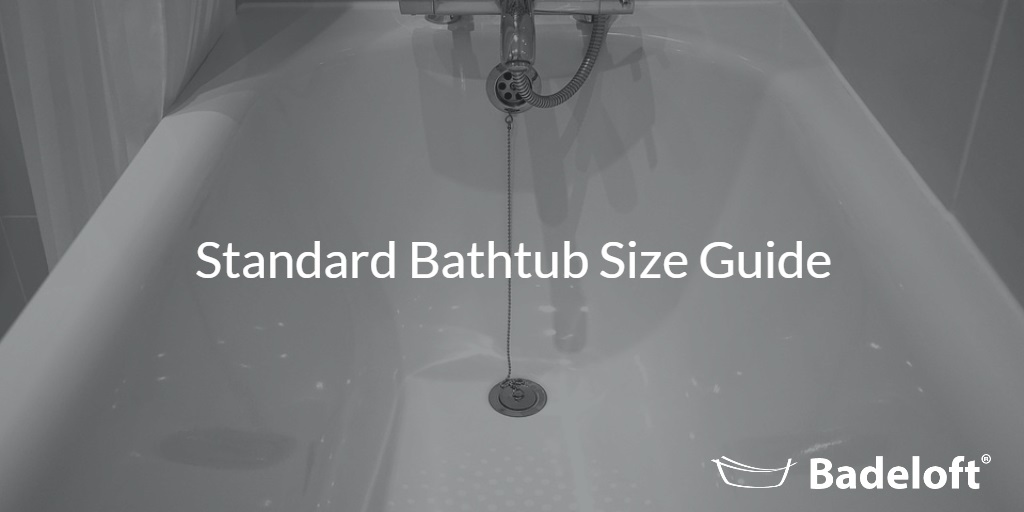
As with a nice scented candle or finely polished glass, the bathtub is an essential part of completing the look
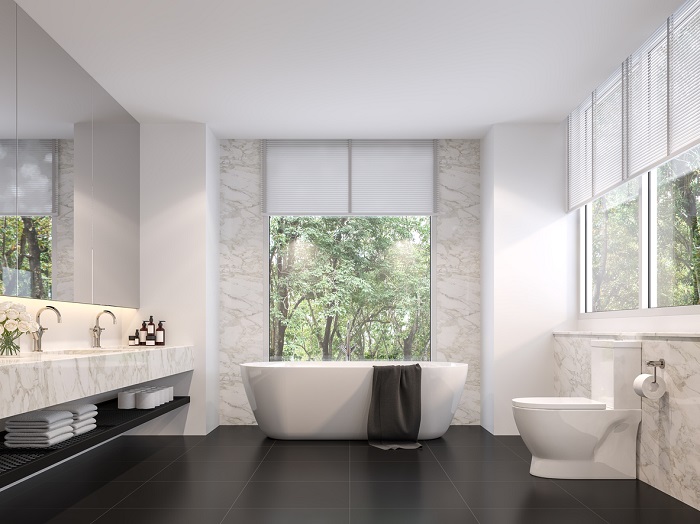
Thinking about installing a new bathroom? Well, before undertaking your project, consider what kind of bathroom you want and how
Fill out the form below to request a free material sample
"*" indicates required fields
"*" indicates required fields
"*" indicates required fields